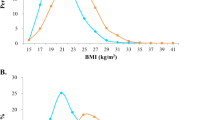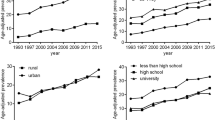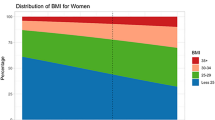Abstract
Background:
Obesity epidemic is related to industrialization and urbanization that have lead to changes in nutrition, lifestyle and socio-economic status. However, information on the trajectory of the obesity epidemic in populations experiencing rapid economic development is limited. We therefore investigate trends in obesity from 2002 to 2010 in a southern Chinese population experiencing world’s fastest economic development.
Methods:
Between 2002 and 2010 four standardized surveys were conducted in a population of 85 million residents in Guangdong, China. Multistage cluster sampling was adopted to recruit representative samples. Weight, height and waist circumference of the participants were measured in a standardized way. The analysis included residents aged between 18 and 69 years. The number of participants included in the present analysis for Surveys conducted in 2002, 2004, 2007 and 2010 were 13058, 7646, 6441 and 8575, respectively.
Results:
From year 2002 to 2010, the age-standardized Body mass index (BMI) insignificantly changed from 21.7 kg m−2 to 22.3 kg m−2, and the prevalence of overweight and overall obesity from 15.8 to 16.6% (both P>0.05). The age-standardized waist circumference increased from 73.7 to 78.4 cm, and prevalence of abdominal obesity increased from 12.9 to 23.7% (both P<0.001). In urban areas, BMI and overall obesity changed little during the 8-year period (BMI increased from 22.6 to 22.7 kg m−2 and overall obesity changed from 23.7 to 21.4%), whereas there were slight increases of the same in rural areas (BMI increased from 20.8 to 22.1 kg m−2and overall obesity increased from 8.2 to 13.3%). Waist circumference and abdominal obesity increased significantly in both areas, but the increase was more pronounced in rural areas (in urban area, waist circumference increased from 75.1 to 78.5 cm and abdominal obesity from 16.8 to 26.5%; in rural area, waist circumference from 72.2 to 78.3 and abdominal obesity from 8.8 to 22.0%).
Conclusions:
BMI and overall obesity in this population, which has experienced the world’s fastest economic development over the past three decades, has been leveling-off, while waist circumference and abdominal obesity, independent predictors of cardiovascular risk, have continued to rise. Our findings suggest that obesity epidemic transition in rapidly developing populations may be much faster than what has been observed in Western countries.
This is a preview of subscription content, access via your institution
Access options
Subscribe to this journal
Receive 12 print issues and online access
$259.00 per year
only $21.58 per issue
Buy this article
- Purchase on Springer Link
- Instant access to full article PDF
Prices may be subject to local taxes which are calculated during checkout

Similar content being viewed by others
References
World Health Organization (WHO). Obesity and overweight. Available at: http://www.Who.Int/mediacentre/factsheets/fs311/en/. accessed on April 11, 2014.
Mitchell RT, McDougall CM, Crum JE . Decreasing prevalence of obesity in primary schoolchildren. Arch Dis Child 2007; 92: 153–154.
Rokholm B, Baker JL, Sorensen TI . The levelling off of the obesity epidemic since the year 1999—a review of evidence and perspectives. Obes Rev 2010; 11: 835–846.
Flegal KM, Carroll MD, Kit BK, Ogden CL . Prevalence of obesity and trends in the distribution of body mass index among US adults, 1999-2010. JAMA 2012; 307: 491–497.
Ogden CL, Carroll MD, Kit BK, Flegal KM . Prevalence of obesity and trends in body mass index among U.S.children and adolescents, 1999-2010. JAMA 2012; 307: 483–490.
Statistics Bureau of Guangdong province. Guangdong statistical yearbook (2011). China Statistics Publishing House, Beijing, China, 2012.
Lao XQ, Xu YJ, Wong MC, Zhang YH, Ma WJ, Xu XJ et al. Hypertension prevalence, awareness, treatment, control and associated factors in a developing southern Chinese population: analysis of serial cross-sectional health survey data 2002-2010. Am J Hypertens 2013; 26: 1335–1345.
WHO Expert ConsultationAppropriate body-mass index for Asian populations and its implications for policy and intervention strategies. Lancet 2004; 363: 157–163.
Alberti KG, Zimmet P, Shaw J . The metabolic syndrome—a new worldwide definition. Lancet 2005; 366: 1059–1062.
Lao XQ, Thompson A, McHutchison JG, McCarthy JJ . Sex and age differences in lipid response to chronic infection with the hepatitis c virus in the United States National Health and Nutrition Examination Surveys. J Viral Hepat 2011; 18: 571–579.
Lao XQ, Zhang YH, Wong MC, Xu YJ, Xu HF, Nie SP et al. The prevalence of metabolic syndrome and cardiovascular risk factors in adults in southern China. BMC Public Health 2012; 12: 64.
Ma WJ, Tang JL, Zhang YH, Xu YJ, Lin JY, Li JS et al. Hypertension prevalence, awareness, treatment, control, and associated factors in adults in southern China. Am J Hypertens 2012; 25: 590–596.
Zhang YH, Ma WJ, Thomas GN, Xu YJ, Lao XQ, Xu XJ et al. Diabetes and pre-diabetes as determined by glycated haemoglobin a1c and glucose levels in a developing southern Chinese population. PLoS One 2012; 7: e37260.
Research report of ecnomic development status in China rural area. Statistics Bureau of China 1995.
Kirkby RJR . The definition of urban population in the People's Republic of China. In: Kirkby RJR (ed.),Urbanization in China: Town and country in a developing economy, 1949–2000 AD. Columbia University Press: New York, NY, USA, 1985, pp54–102.
Wildman RP, Gu D, Muntner P, Wu X, Reynolds K, Duan X et al. Trends in overweight and obesity in Chinese adults: Between 1991 and 1999-2000. Obesity (Silver Spring) 2008; 16: 1448–1453.
Xi B, Liang Y, He T, Reilly KH, Hu Y, Wang Q et al. Secular trends in the prevalence of general and abdominal obesity among Chinese adults, 1993-2009. Obes Rev 2012; 13: 287–296.
Wang H, Du S, Zhai F, Popkin BM . Trends in the distribution of body mass index among Chinese adults, aged 20-45 years (1989-2000). Int J Obes (Lond) 2007; 31: 272–278.
Zhang YH, Ma WJ, HY XIE, YJ. XU . The changing trend of dietary pattern among Guangdong population from 1982-2002. S Chin J Prev Med 2010; 36: 1–5.
Ge KY, Zhai FY, Yuan HC, Cheng L, Wang Q, Jia FM . The dietary and nutritional status of Chinese populations in 1990s (1992 National Nutrition Survey). Acta Nutr Sin 1995; 17: 123–134.
Thomas GN, Ho SY, Lam KS, Janus ED, Hedley AJ, Lam TH . Impact of obesity and body fat distribution on cardiovascular risk factors in Hong Kong Chinese. Obes Res 2004; 12: 1805–1813.
Pischon T, Boeing H, Hoffmann K, Bergmann M, Schulze MB, Overvad K et al General and abdominal adiposity and risk of death in Europe. N Engl J Med 2008; 359: 2105–2120.
Zhang C, Rexrode KM, van Dam RM, Li TY, Hu FB . Abdominal obesity and the risk of all-cause, cardiovascular, and cancer mortality: sixteen years of follow-up in US women. Circulation 2008; 117: 1658–1667.
Ford ES, Li C, Zhao G, Tsai J . Trends in obesity and abdominal obesity among adults in the United States from 1999-2008. Int J Obes (Lond) 2011; 35: 736–743.
Ko GT, Tang JS, Chan JC . Worsening trend of central obesity despite stable or declining body mass index in Hong Kong Chinese between 1996 and 2005. Eur J Clin Nutr 2010; 64: 549–552.
Camoes M, Lopes C, Oliveira A, Santos AC, Barros H . Overall and central obesity incidence in an urban Portuguese population. Prev Med 2010; 50: 50–55.
McCarthy HD, Ellis SM, Cole TJ . Central overweight and obesity in British youth aged 11-16 years: cross sectional surveys of waist circumference. BMJ 2003; 326: 624.
Li C, Ford ES, McGuire LC, Mokdad AH . Increasing trends in waist circumference and abdominal obesity among U.S. adults. Obesity (Silver Spring) 2007; 15: 216–224.
Wells JC, Coward WA, Cole TJ, Davies PS . The contribution of fat and fat-free tissue to body mass index in contemporary children and the reference child. Int J Obes Relat Metab Disord 2002; 26: 1323–1328.
Omran AR . The epidemiologic transition. A theory of the epidemiology of population change. Milbank Mem Fund Q 1971; 49: 509–538.
Omran AR . A century of epidemiologic transition in the United States. Prev Med 1977; 6: 30–51.
Yang G, Wang Y, Zeng Y, Gao GF, Liang X, Zhou M et al. Rapid health transition in China, 1990-2010: Findings from the Global Burden of Disease Study 2010. Lancet 2013; 381: 1987–2015.
Population division of the department of economic and social affairs of the United Nations Secretariat (2011). World population prospects: The 2010 revision. United Nations, New York, NY, USA.
Flegal KM, Carroll MD, Ogden CL, Curtin LR . Prevalence and trends in obesity among U.S. adults, 1999-2008. JAMA 2010; 303: 235–241.
Acknowledgements
We thank all of the participants for their generous assistance. We also thank all of the staff of the survey team for their efforts which made this study possible. These surveys were supported by the National Natural Science Foundation of China (81373081); the Guangdong Science and Technology Fund (2002 C32709), Guangzhou, China; the China Ministry of Health Special Fund (2001DEA30035), Beijing, China; the China Ministry of Science and Technology Key Research Fund (2003DIA6N008), Beijing, China; and the Ministry of Finance of the People’s Republic of China, Beijing, China.
Author information
Authors and Affiliations
Corresponding author
Ethics declarations
Competing interests
The authors declare no conflict of interest.
Additional information
Supplementary Information accompanies this paper on International Journal of Obesity website
Supplementary information
Rights and permissions
About this article
Cite this article
Lao, X., Ma, W., Sobko, T. et al. Overall obesity is leveling-off while abdominal obesity continues to rise in a Chinese population experiencing rapid economic development: analysis of serial cross-sectional health survey data 2002–2010. Int J Obes 39, 288–294 (2015). https://doi.org/10.1038/ijo.2014.95
Received:
Revised:
Accepted:
Published:
Issue Date:
DOI: https://doi.org/10.1038/ijo.2014.95
This article is cited by
-
Gender-specific temporal trends in overweight prevalence among Chinese adults: a hierarchical age-period-cohort analysis from 2008 to 2015
Global Health Research and Policy (2020)
-
Waist circumference is a better predictor of risk for frailty than BMI in the community-dwelling elderly in Beijing
Aging Clinical and Experimental Research (2018)
-
Environmental/lifestyle factors in the pathogenesis and prevention of type 2 diabetes
BMC Medicine (2017)
-
Contextual influences affecting patterns of overweight and obesity among university students: a 50 universities population-based study in China
International Journal of Health Geographics (2017)
-
Changes in waist circumference and the prevalence of abdominal obesity during 1994–2008 - cross-sectional and longitudinal results from two surveys: the Tromsø Study
BMC Obesity (2016)



